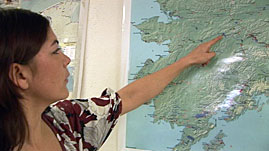Teachers' Domain - Digital Media for the Classroom and Professional Development
User: Preview

Source: Produced for Teachers' Domain
This video produced for Teachers’ Domain profiles La'ona DeWilde, an Athabascan and doctoral student in environmental biology. DeWilde chose her career because of her strong traditional belief in respecting animals and caring for the environment. Her work today involves helping local villagers record observations that can be used collaboratively with Western science to help solve problems that affect Alaska Native peoples, including climate change and water contamination.
Inspired by her traditional upbringing to both respect and protect the natural world, La'ona DeWilde, an Athabascan and doctoral student in environmental biology, utilizes Western technology to collect and store environmental data most pertinent to the concerns of Alaska Native communities. She records local travel routes in her Global Positioning System (GPS) device and identifies, with the help of local residents, geographical information important to her fieldwork.
Environmental biologists study living populations and their interactions with their environment. They consider factors such as air, soil, and water and how they affect life. They look not only at plant and animal ecology, but also at the impacts humans have on ecosystems. Some environmental biologists study wetlands to help determine whether construction projects should be approved, while others determine the effects of industrial waste released into the environment.
Fieldwork is an important component of environmental biology. Before laboratory analysis can be done to determine soil contamination or water quality, someone must first collect samples from a study site. Only after both jobs have been completed can remedial projects be proposed. Apart from perhaps the most obvious obstacle—working in a cold climate where soil and water are frozen more often than not—Alaska's sparsely populated landscape makes performing scientific fieldwork especially challenging.
Alaska has the largest land area of all the U.S. states. With just 1.1 persons per square mile (or 0.42 per square kilometer), it is also the most sparsely settled. While more than half of Alaska's population lives in its three largest cities, many communities across the state are made up of fewer than 300 people. Most of these smaller communities are spread far apart along coastlines or rivers to support Alaska Native subsistence activities. Most villages and towns, including the state capitol of Juneau, cannot be reached by roads. While car travel may be possible in some areas, boat or small plane travel is required to reach most other areas.
Despite the mapping efforts made during historic periods of resource exploration and development activities, much of Alaska remains uncharted. Information concerning many outlying Alaska Native villages does not appear in a geographic information system (GIS) database or other mapping system. Consequently, the local geography is not well understood by Western scientists. This makes the work of scientists like La'ona DeWilde even more significant.
Water contamination has been a major concern for Alaska Native communities for several decades, especially after small nomadic groups began to settle down in villages. As village populations have grown, so has the need for water and sewage systems to deal with accumulating waste. Lacking proper sanitation technology, a local water supply can easily become contaminated and spread disease. DeWilde hopes that by helping villagers develop a greater awareness of the problems they face, they will collect and share observations with Western scientists that will in turn lead to solutions that ensure their well-being.
 Loading Standards
Loading Standards Teachers' Domain is proud to be a Pathways portal to the National Science Digital Library.
Teachers' Domain is proud to be a Pathways portal to the National Science Digital Library.
